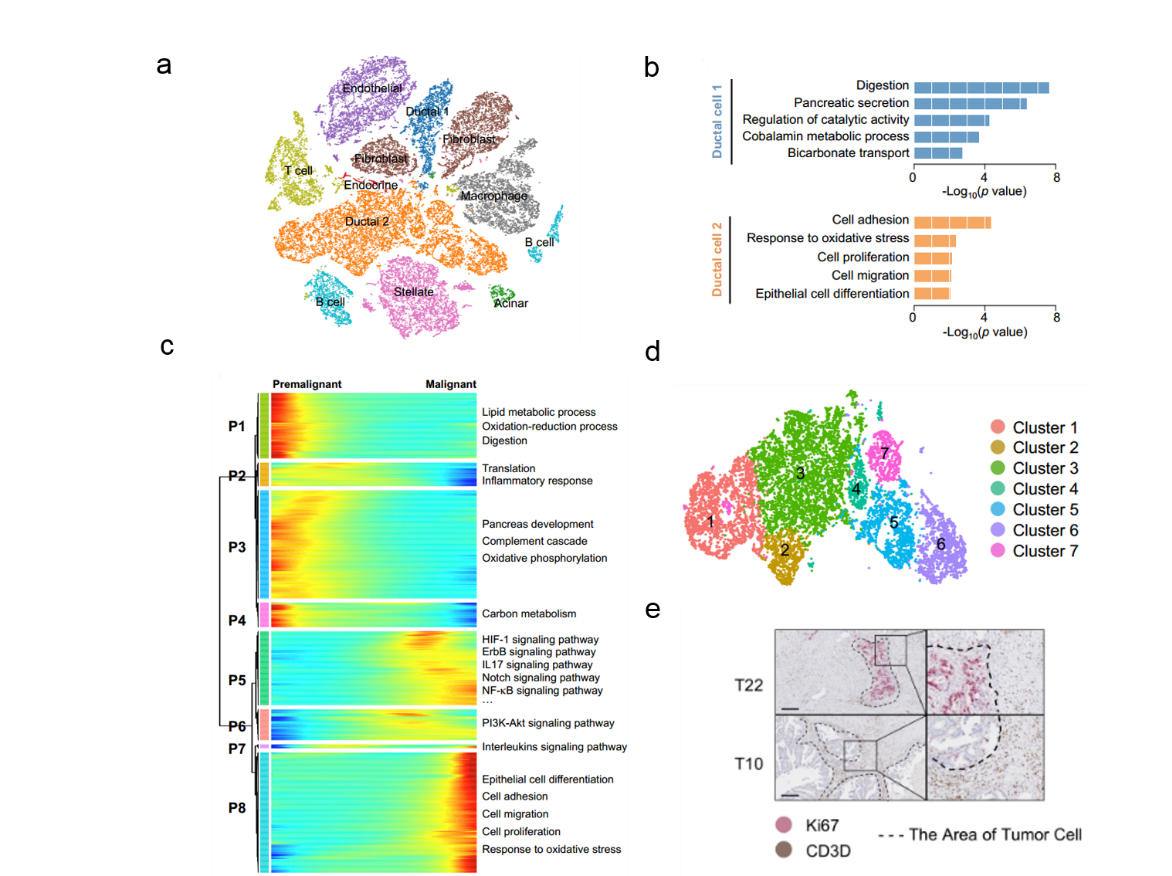Pancreatic ductal adenocarcinoma (PDAC), known as the "king of cancers", is the most common type of pancreatic cancer featured with high intra-tumoral heterogeneity and poor prognosis. To solve this major frontier medical problem, the Health Science Research Center has been jointly established by the Chinese Academy of Sciences (CAS) and Peking Union Medical College Hospital, and Academicians ZHAO Yupei and ZHOU Qi serve as the science advisers. Under the support of this center, the research teams of YANG Yungui and HAN Dali from Beijing Institute of Genomics, and WU Wenming from Peking Union Medical College Hospital collaboratively explore the molecular mechanism of PDAC development and the regulatory roles of the tumor microenvironment. Using the state of the art single cell transcriptome sequencing technology, they have systematically delineated the cell types in noncancerous pancreas and PDAC patient samples, and demonstrated the high heterogeneity feature in both pancreatic tumor cells and tumor microenvironment and the relationship between the subgroup of tumor cells and infiltrated immune cells, providing new potential therapeutic targets for PDAC. They mapped the transcriptome in a large number of pancreatic duct adenocarcinoma cells by single-cell transcriptome analysis, including 41,986 cells from pancreatic cancer tissues of 24 PDAC patients who had not received any preoperative chemoradiotherapy and 15,544 cells from 11 control pancreases tissues. They first applied principle component analysis (t-SNE) on variably expressed genes across all cells and identified 10 main clusters including type I ductal, type II ductal, acinar, endocrine, endothelial, fibroblast, stellate, macrophage, T and B cells. The type II ductal cells were identified as malignant cells in PDAC by copy number variation (CNV) combined with the analyses of differential gene expression and functional enrichment. Secondly, trajectory analysis was used to explore the gene expression pattern of PDAC during the transformation process from precancerous to malignant state, and several classical oncogenic pathways were identified to be activated during PDAC progression, including ErbB and Notch signaling pathways. In addition, genes related to cell proliferation and migration are significantly activated, especially in the late stages of tumor progression. They have also identified 7 subgroups in type II ductal cells, among which the feature genes of subgroup 7 (proliferative ductal subgroup) were enriched in cell cycle and proliferation-related pathways. Further, by integrated analysis on the TCGA pancreatic cancer cohort (PAAD) data, a significant negative correlation between the expression level of the feature genes of proliferative ductal cells and the activation of tumor infiltrating T cells was identified. Pathological section staining also demonstrated this correlation, suggesting that the presence of proliferative ductal cells and the absence of activated T cells may jointly contribute to poor prognosis in PDAC patients. This study has provided an important transcriptomic resource for exploring the pathogenesis of pancreatic ductal adenocarcinoma and potential role of tumor microenvironment. Importantly, the findings reveal a new mechanism in which proliferative ductal subgroup can inhibit T cell infiltration and activation, therefore, propose the feasible and precise therapeutic targets, such as CDK1, PLK1, AURKA and other proliferative subgroup ductal markers, and meanwhile provide a new research direction for accurate diagnosis and treatment of PDAC. The research was published online in Cell Research,and funded by the Key Research Program of the CAS, and so on. High heterogeneity of tumor and tumor microenvironment in PDAC (Image by YANG Yungui's group) Contact : Dr. YANG Yungui Dr. WU Wenming 
Beijing Institute of Genomics
E-mail: ygyang@big.ac.cn
Peking Union Medical College Hospital
E-mail: doctorwuu@126.com
